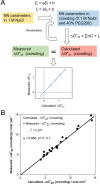Validation of the nearest-neighbor model for Watson-Crick self-complementary DNA duplexes in molecular crowding condition
- PMID: 30753582
- PMCID: PMC6468326
- DOI: 10.1093/nar/gkz071
Validation of the nearest-neighbor model for Watson-Crick self-complementary DNA duplexes in molecular crowding condition
Abstract
Recent advancement in nucleic acid techniques inside cells demands the knowledge of the stability of nucleic acid structures in molecular crowding. The nearest-neighbor model has been successfully used to predict thermodynamic parameters for the formation of nucleic acid duplexes, with significant accuracy in a dilute solution. However, knowledge about the applicability of the model in molecular crowding is still limited. To determine and predict the stabilities of DNA duplexes in a cell-like crowded environment, we systematically investigated the validity of the nearest-neighbor model for Watson-Crick self-complementary DNA duplexes in molecular crowding. The thermodynamic parameters for the duplex formation were measured in the presence of 40 wt% poly(ethylene glycol)200 for different self-complementary DNA oligonucleotides consisting of identical nearest-neighbors in a physiological buffer containing 0.1 M NaCl. The thermodynamic parameters as well as the melting temperatures (Tm) obtained from the UV melting studies revealed similar values for the oligonucleotides having identical nearest-neighbors, suggesting the validity of the nearest-neighbor model in the crowding condition. Linear relationships between the measured ΔG°37 and Tm in crowding condition and those predicted in dilute solutions allowed us to predict ΔG°37, Tm and nearest-neighbor parameters in molecular crowding using existing parameters in the dilute condition, which provides useful information about the thermostability of the self-complementary DNA duplexes in molecular crowding.
© The Author(s) 2019. Published by Oxford University Press on behalf of Nucleic Acids Research.
Figures




Similar articles
-
Nearest-neighbor parameters for predicting DNA duplex stability in diverse molecular crowding conditions.Proc Natl Acad Sci U S A. 2020 Jun 23;117(25):14194-14201. doi: 10.1073/pnas.1920886117. Epub 2020 Jun 10. Proc Natl Acad Sci U S A. 2020. PMID: 32522884 Free PMC article.
-
Thermodynamic characterization and nearest neighbor parameters for RNA duplexes under molecular crowding conditions.Nucleic Acids Res. 2019 Apr 23;47(7):3658-3666. doi: 10.1093/nar/gkz019. Nucleic Acids Res. 2019. PMID: 30698818 Free PMC article.
-
Thermodynamic parameters for an expanded nearest-neighbor model for formation of RNA duplexes with Watson-Crick base pairs.Biochemistry. 1998 Oct 20;37(42):14719-35. doi: 10.1021/bi9809425. Biochemistry. 1998. PMID: 9778347
-
Prediction of melting temperatures in fluorescence in situ hybridization (FISH) procedures using thermodynamic models.Crit Rev Biotechnol. 2016;36(3):566-77. doi: 10.3109/07388551.2014.993589. Epub 2015 Jan 14. Crit Rev Biotechnol. 2016. PMID: 25586037 Review.
-
Thermodynamics of base pairing.Curr Opin Struct Biol. 1996 Jun;6(3):299-304. doi: 10.1016/s0959-440x(96)80047-9. Curr Opin Struct Biol. 1996. PMID: 8804832 Review.
Cited by
-
Pairing statistics and melting of random DNA oligomers: Finding your partner in superdiverse environments.PLoS Comput Biol. 2022 Apr 11;18(4):e1010051. doi: 10.1371/journal.pcbi.1010051. eCollection 2022 Apr. PLoS Comput Biol. 2022. PMID: 35404933 Free PMC article.
-
Likelihood of Nonspecific Activity of Gapmer Antisense Oligonucleotides Is Associated with Relative Hybridization Free Energy.Nucleic Acid Ther. 2020 Aug;30(4):215-228. doi: 10.1089/nat.2020.0847. Epub 2020 Mar 3. Nucleic Acid Ther. 2020. PMID: 32125928 Free PMC article.
-
Twisting tetraplex DNA: A strand dynamics regulating i-motif function in diverse molecular crowding environments.Nucleic Acids Res. 2025 Jun 20;53(12):gkaf500. doi: 10.1093/nar/gkaf500. Nucleic Acids Res. 2025. PMID: 40586303 Free PMC article.
-
RNA structure promotes liquid-to-solid phase transition of short RNAs in neuronal dysfunction.Commun Biol. 2024 Jan 29;7(1):137. doi: 10.1038/s42003-024-05828-z. Commun Biol. 2024. PMID: 38287096 Free PMC article.
-
Dielectricity of a molecularly crowded solution accelerates NTP misincorporation during RNA-dependent RNA polymerization by T7 RNA polymerase.Sci Rep. 2022 Jan 21;12(1):1149. doi: 10.1038/s41598-022-05136-8. Sci Rep. 2022. PMID: 35064200 Free PMC article.
References
-
- Saiki R.K., Gelfand D.H., Stoffel S., Scharf S.J., Higuchi R., Horn G.T., Mullis K.B., Erlich H.A.. Primer-directed enzymatic amplification of DNA with a thermostable DNA polymerase. Science. 1988; 239:487–491. - PubMed
-
- Fodor S.P., Rava R.P., Huang X.C., Pease A.C., Holmes C.P., Adams C.L.. Multiplexed biochemical assays with biological chips. Nature. 1993; 364:555–556. - PubMed
-
- Crooke S.T., Lebleu B.. Antisense Research and Applications. 1993; Boca Raton: CRC Press.
Publication types
MeSH terms
Substances
LinkOut - more resources
Full Text Sources
Molecular Biology Databases

